Related Research Articles

Hornblende is a complex inosilicate series of minerals. It is not a recognized mineral in its own right, but the name is used as a general or field term, to refer to a dark amphibole. Hornblende minerals are common in igneous and metamorphic rocks.

The pyroxenes are a group of important rock-forming inosilicate minerals found in many igneous and metamorphic rocks. Pyroxenes have the general formula XY(Si,Al)2O6, where X represents calcium (Ca), sodium (Na), iron or magnesium (Mg) and more rarely zinc, manganese or lithium, and Y represents ions of smaller size, such as chromium (Cr), aluminium (Al), magnesium (Mg), cobalt (Co), manganese (Mn), scandium (Sc), titanium (Ti), vanadium (V) or even iron. Although aluminium substitutes extensively for silicon in silicates such as feldspars and amphiboles, the substitution occurs only to a limited extent in most pyroxenes. They share a common structure consisting of single chains of silica tetrahedra. Pyroxenes that crystallize in the monoclinic system are known as clinopyroxenes and those that crystallize in the orthorhombic system are known as orthopyroxenes.
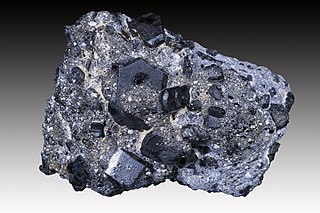
Augite, also known as Augurite, is a common rock-forming pyroxene mineral with formula (Ca,Na)(Mg,Fe,Al,Ti)(Si,Al)2O6. The crystals are monoclinic and prismatic. Augite has two prominent cleavages, meeting at angles near 90 degrees.
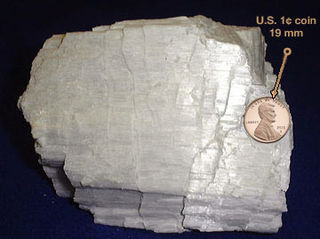
Wollastonite is a calcium inosilicate mineral (CaSiO3) that may contain small amounts of iron, magnesium, and manganese substituting for calcium. It is usually white. It forms when impure limestone or dolomite is subjected to high temperature and pressure, which sometimes occurs in the presence of silica-bearing fluids as in skarns or in contact with metamorphic rocks. Associated minerals include garnets, vesuvianite, diopside, tremolite, epidote, plagioclase feldspar, pyroxene and calcite. It is named after the English chemist and mineralogist William Hyde Wollaston (1766–1828).

Forsterite (Mg2SiO4; commonly abbreviated as Fo; also known as white olivine) is the magnesium-rich end-member of the olivine solid solution series. It is isomorphous with the iron-rich end-member, fayalite. Forsterite crystallizes in the orthorhombic system (space group Pbnm) with cell parameters a 4.75 Å (0.475 nm), b 10.20 Å (1.020 nm) and c 5.98 Å (0.598 nm).
Diallage is an inosilicate, meaning it is a chain silicate, and is a part of the pyroxene group. Diallage is a junction between augite and diopside, just like fassaite. It was named in 1801 by René Just Haüy. Its name derives from the Greek word diallaghé, as its composition differs from that of the other minerals in the pyroxene group. It is a fairly common mineral, and is cheap.

Silicate minerals are rock-forming minerals made up of silicate groups. They are the largest and most important class of minerals and make up approximately 90 percent of Earth's crust.

Gmelinite-Na is one of the rarer zeolites but the most common member of the gmelinite series, gmelinite-Ca, gmelinite-K and gmelinite-Na. It is closely related to the very similar mineral chabazite. Gmelinite was named as a single species in 1825 after Christian Gottlob Gmelin (1792–1860) professor of chemistry and mineralogist from Tübingen, Germany, and in 1997 it was raised to the status of a series.
Gmelinite-Na has been synthesised from Na-bearing aluminosilicate gels. The naturally occurring mineral forms striking crystals, shallow, six sided double pyramids, which can be colorless, white, pale yellow, greenish, orange, pink, and red. They have been compared to an angular flying saucer.
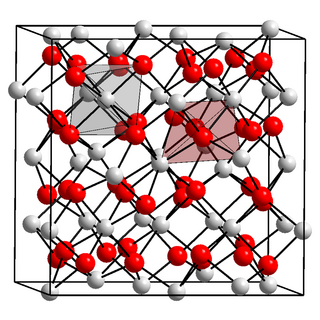
Scandium(III) oxide or scandia is a inorganic compound with formula Sc2O3. It is one of several oxides of rare earth elements with a high melting point. It is used in the preparation of other scandium compounds as well as in high-temperature systems (for its resistance to heat and thermal shock), electronic ceramics, and glass composition (as a helper material).

Clinozoisite is a complex calcium aluminium sorosilicate mineral with formula: Ca2Al3(Si2O7)(SiO4)O(OH). It forms a continuous solid solution series with epidote by substitution of iron(III) in the aluminium (m3 site) and is also called aluminium epidote.
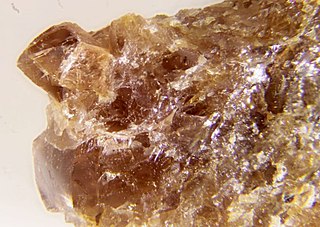
Pyroxferroite (Fe2+,Ca)SiO3 is a single chain inosilicate. It is mostly composed of iron, silicon and oxygen, with smaller fractions of calcium and several other metals. Together with armalcolite and tranquillityite, it is one of the three minerals which were discovered on the Moon during the 1969 Apollo 11 mission. It was then found in Lunar and Martian meteorites as well as a mineral in the Earth's crust. Pyroxferroite can also be produced by annealing synthetic clinopyroxene at high pressures and temperatures. The mineral is metastable and gradually decomposes at ambient conditions, but this process can take billions of years.

Melilite refers to a mineral of the melilite group. Minerals of the group are solid solutions of several endmembers, the most important of which are gehlenite and åkermanite. A generalized formula for common melilite is (Ca,Na)2(Al,Mg,Fe2+)[(Al,Si)SiO7]. Discovered in 1793 near Rome, it has a yellowish, greenish-brown color. The name derives from the Greek words meli (μέλι) "honey" and lithos (λίθους) "stone".The name refers to a group of minerals (melilite group) with chemically similar composition, nearly always minerals in åkermanite-gehlenite series.

The endmember hornblende tschermakite (☐Ca2(Mg3Al2)(Si6Al2)O22(OH)2) is a calcium rich monoclinic amphibole mineral. It is frequently synthesized along with its ternary solid solution series members tremolite and cummingtonite so that the thermodynamic properties of its assemblage can be applied to solving other solid solution series from a variety of amphibole minerals.
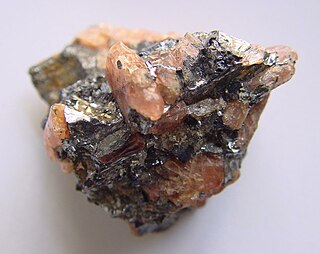
Bustamite is a calcium manganese inosilicate (chain silicate) and a member of the wollastonite group. Magnesium, zinc and iron are common impurities substituting for manganese. Bustamite is the high-temperature polymorph of CaMnSi2O6 and johannsenite is the low temperature polymorph. The inversion takes place at 830 °C (1,530 °F), but may be very slow.
Bustamite could be confused with light-colored rhodonite or pyroxmangite, but both these minerals are biaxial (+) whereas bustamite is biaxial (−).
Kangite is an exceedingly rare scandium mineral, a natural form of impure scandium oxide (Sc2O3), with the formula (Sc,Ti,Al,Zr,Mg,Ca,□)2O3. It crystallizes in the cubic crystal system diploidal class. In terms of chemistry it scandium-analogue of tistarite. Both kangite and tistarite were discovered in the Allende meteorite.
Grossmanite is a very rare mineral of the pyroxene group, with formula CaTi3+AlSiO6. It is the titanium-dominant member. Grossmanite is unique in being a mineral with trivalent titanium, a feature shared with tistarite, Ti2O3. Titanium in minerals is almost exclusively tetravalent. Grossmanite stands for titanium-analogue of davisite, esseneite and kushiroite – other members of the pyroxene group. Both grossmanite and tistarite come from the famous Allende meteorite.
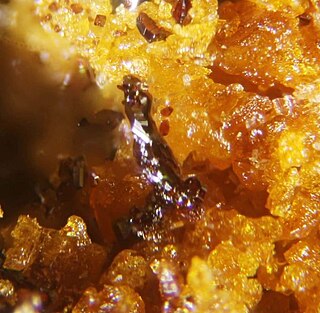
Esseneite is a relative rare mineral of the pyroxene group, with formula CaFeAlSiO6. It is the ferric-iron-dominant member. Esseneite is an iron-analogue of other pyroxene-group members, davisite, grossmanite, and kushiroite. It is a metamorphic mineral forming in pyrometamorphic rocks called paralavas, which are formed due to fusing on sedimentary rocks usually in result of coal fires. Esseneite is found in both natural and anthropogenic coal-fire sites.
Kushiroite is a rare mineral of the pyroxene group, with formula CaAlAlSiO6. It is the fully aluminian member. The formula of kushiroite corresponds to the molecule (or component) known as Calcium-Tschermak (Ca-Tschermak), which dominates in the composition of kushiroite. Kushiroite is an aluminium-analogue of other pyroxene-group members, davisite, esseneite, and grossmanite. It was found in a chondrite meteorite within refractory inclusions.
Eric J. Essene was a professor emeritus of geosciences and a metamorphic petrologist at the University of Michigan. In 2010, Essene was awarded the Penrose Medal by the Geological Society of America. He was a leader in the development of geothermobarometry as a tool in understanding the rock assemblages of high grade metamorphic suites and the evolution of continental crust.
References
- ↑ Ma, C., and Rossmann, G.R., 2009: Davisite, CaScAlSiO6, a new pyroxene from the Allende meteorite
- 1 2 Mindat, http://www.mindat.org/min-38829.html
- ↑ Scandium, The mineralogy of Scandium - Mindat. org
- ↑ Ohashi, H.; Ii, N. (1978). "Structure of calcium scandium aluminum silicate (CaScAlSiO6)-pyroxene". Journal of the Japanese Association of Mineralogists, Petrologists and Economic Geologists. 73: 267–273. doi: 10.2465/ganko1941.73.267 .